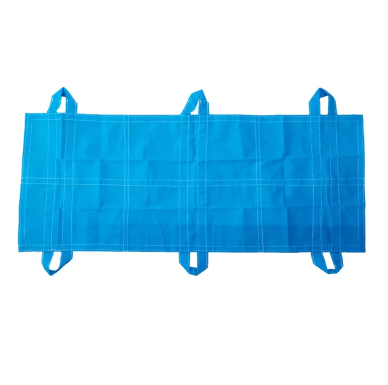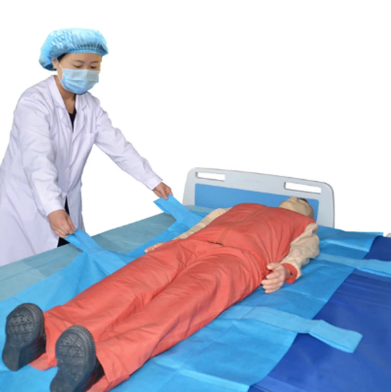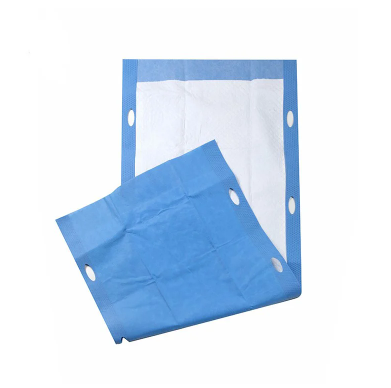When it comes to patient transfers, choosing the right transfer sheet is crucial for ensuring the safety, comfort, and well-being of both patients and healthcare providers. With various types of transfer sheets available in the market, it's essential to consider factors such as material, size, sliding capabilities, handles, cleaning requirements, patient comfort, safety features, compatibility with transfer equipment, cost, and regulatory compliance. This comprehensive guide will provide valuable insights into selecting the appropriate patient transfer sheet based on these considerations, promoting efficient and secure transfers within medical settings.
When it comes to patient transfers, there are several different types of transfer sheets to choose from. Here are some common types.
These sheets are typically made of durable and waterproof materials and are designed to be replaced after each use by a patient. They offer the advantage of preventing cross-contamination as each patient uses their own individual sheet.
In contrast todisposable sheets, reusable transfer sheets are made of more durable materials and can be reused after appropriate cleaning and disinfection. These sheets typically require regular maintenance and cleaning to ensure compliance with hygiene standards.
Slide sheets are usually made of low-friction materials such as special coatings, boards, or low-friction fibers. They are designed to reduce friction and shear forces during patient transfers, making movement easier. Slide sheets are commonly used for transferring patients who require additional sliding assistance, such as non-ambulatory or mobility-restricted patients.

Draw sheet systems typically consist of a long and wide sheet that can be placed on top of a mattress and used to assist patients in moving within the bed. These sheets are often made of non-slip materials to prevent the patient from sliding or slipping during movement. Draw sheet systems can be used to help patients change positions, roll, or transfer to other surfaces.
The selection of the appropriate patient transfer sheet should be based on the specific medical setting and patient needs. Healthcare professionals should ensure that the chosen sheets meet hygiene standards and carefully inspect their condition before use to ensure patient safety and comfort.
When choosing a patient transfer sheet, there are several important factors to consider. These considerations will help ensure the safety and comfort of both the patient and the healthcare provider during the transfer process. Here are some key factors to keep in mind:
The material and construction of the transfer sheet play a crucial role in its effectiveness and durability. Look for a transfer sheet made of strong, tear-resistant materials such as nylon or polyester. Reinforced stitching and handles can also enhance its strength.
Consider the size and weight capacity of the transfer sheet to ensure it can accommodate your specific needs. Different patients may require different dimensions and weight support. Ensure that the sheet is wide enough to comfortably support the patient and long enough to cover their entire body.
The transfer sheet should have properties that reduce friction, allowing for smooth and easy movement of the patient. This helps prevent skin shearing and injuries during transfers. Look for sheets with low-friction coatings or specialized designs that promote easy sliding.
Ergonomically designed handles or grips on the transfer sheet can aid in positioning, gripping, and maneuvering the patient during transfers. Multiple handles placed strategically along the sheet allow for better control and balance while minimizing strain on the healthcare provider's body.
Choose a transfer sheet that is easy to clean and maintain to uphold good hygiene standards. Machine-washable and quick-drying sheets are preferred as they can be reused after proper cleaning and disinfection.
Patient Comfort:
Comfort is paramount when selecting a transfer sheet. Look for sheets with soft and breathable material to minimize discomfort for the patient. Additionally, consider features like padding or extra cushioning in areas that come into direct contact with the patient's body.
Ensure that the transfer sheet has appropriate safety features to prevent accidents or mishaps during transfers. These may include nonslip surfaces, secure attachment points, or quick-release buckles to provide additional security and stability.
If you plan to use transfer equipment like hoists or slide boards, make sure the transfer sheet is compatible with those devices. Check for compatibility specifications provided by the manufacturer or consult with healthcare professionals for guidance.
Consider the cost of the transfer sheet while keeping in mind your budgetary constraints. Balance the price with the required features and quality to find the best value-for-money option.
Regulatory Compliance:
Ensure that the transfer sheet meets relevant regulatory standards and certifications. Look for products that comply with safety regulations and have undergone testing for quality assurance.

Transfer sheets may feature strong handles or straps that allow caregivers to maintain a secure grip during transfers, reducing the risk of dropping the patient.
Some transfer sheets have built-in padding or cushioning to provide additional comfort during transfers, minimizing discomfort and pressure points for the patient.
Certain transfer sheets may have antimicrobial properties to inhibit the growth of bacteria and reduce the risk of infections. Waterproof coatings can protect the sheet from spills and stains.
Transfer sheets with ergonomic designs consider the caregiver's comfort and ease of use. They may have features like handles at different heights or cutouts for better grip and maneuverability.
To simplify the identification and selection of the right transfer sheet, some manufacturers use color-coded systems. Each color represents a specific size or weight capacity, making it easier for caregivers to choose the appropriate sheet.
When considering patient transfer sheets, it's important to balance the quality of the product with its affordability. Cheaper options may have lower durability or fewer features, while more expensive ones may offer enhanced functionality but come at a higher cost.
Reusable transfer sheets may initially be more expensive than disposable ones, but they can provide long-term cost savings. By investing in durable and washable sheets, caregivers can minimize ongoing expenses associated with frequent replacement.
It is worth exploring insurance coverage and reimbursement options for patient transfer sheets. Some healthcare plans or government programs may provide financial assistance or partial reimbursement for the purchase of essential medical equipment.

Founded in 2006, Wellmien is a leading company specializing in disposable medical supplies and Personal Protection Equipment (PPE). We integrate design, manufacture, and sales capacities to provide high-quality products.
Our wide range of products includes face masks, gowns, coveralls, aprons, bouffant caps, shoe covers, sleeve covers, under pads, disposable gloves, wound-care products, first-aid products, and surgical packs. These products are widely used in hospitals, care centers, wholesalers, government agencies, food industries, and households worldwide.
At Wellmien, we prioritize patient safety and comfort during transfers. By considering factors such as material, construction, size, weight capacity, and regulatory compliance, healthcare professionals can confidently select the appropriate patient transfer sheet from our offerings.
With our commitment to excellence and OEM services, we ensure that our customers receive customized products that meet their specific needs. Our annual sales exceed 20 million USD, reflecting the trust and satisfaction our customers have in our products and services.
Partnering with Wellmien means prioritizing patient safety, comfort, and hygiene standards while balancing budgetary constraints. Together, we enhance the overall quality of care provided to patients.